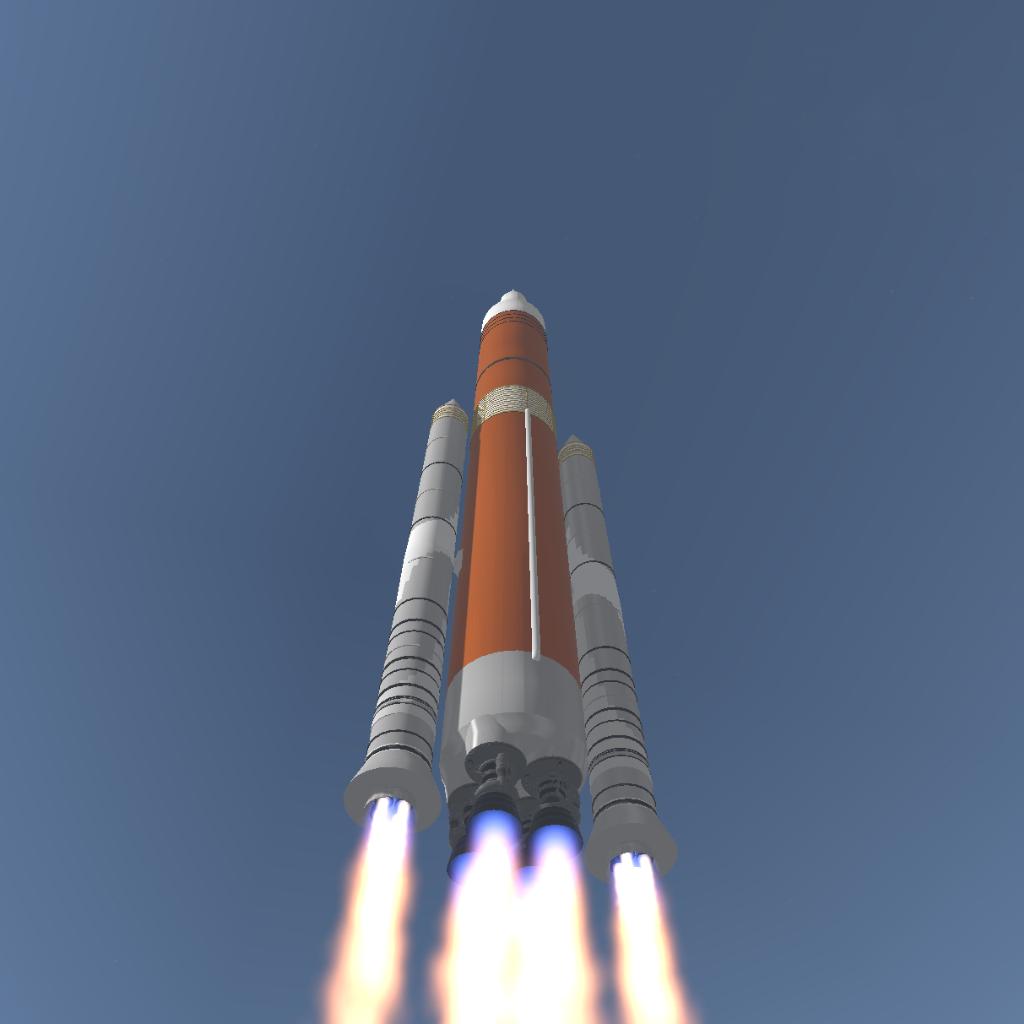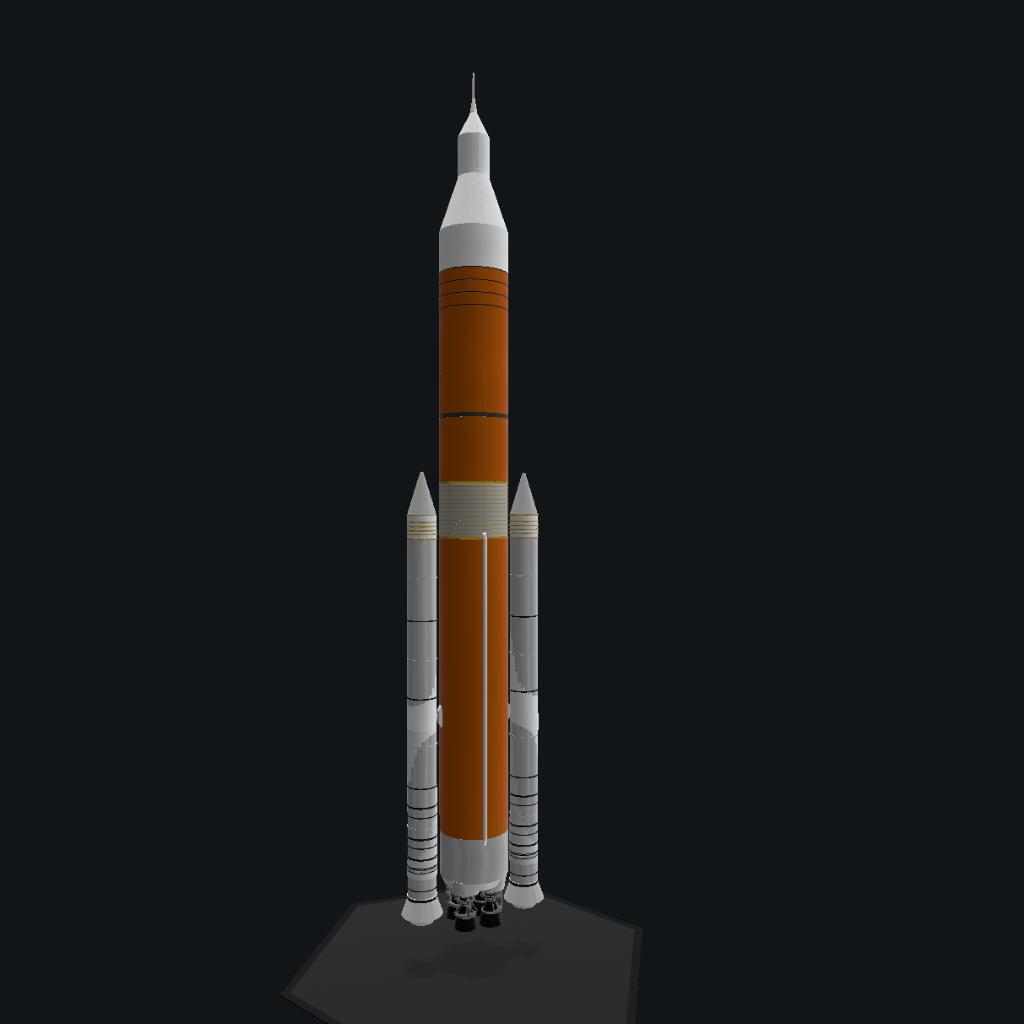The Space Launch System (SLS) is planned to be a US super heavy-lift expendable launch vehicle, which has been under development since its announcement in 2011. It is the primary launch vehicle of NASA's deep space exploration plans, including the planned crewed lunar flights of the Artemis program and a possible follow-on human mission to Mars. SLS replaces the Constellation program's Ares V launch vehicle of 2005, which never left the development phase.
The initial variant of SLS, Block 1, was required by the US Congress to lift a payload of 70 metric tons (150,000 lb) to low Earth orbit (LEO), but exceeded that requirement with a rated payload capacity of 95 metric tons (209,000 lb).As of December 22, 2019, this variant is planned to launch Artemis 1, 2, and 3. The later Block 1B is intended to debut the Exploration Upper Stage and launch the notional Artemis 4 through Artemis 7. Block 2 is planned to replace the initial Shuttle-derived boosters with advanced boosters and would have a LEO capability of more than 130 metric tons (290,000 lb), again as required by Congress. Block 2 is intended to enable crewed launches to Mars. The SLS will launch the Orion spacecraft and use the ground operations and launch facilities at NASA's Kennedy Space Center in Florida.
Vehicle description
The SLS is a Space Shuttle-derived launch vehicle and will have the ability to tolerate a minimum of 13 tanking cycles due to launch scrubs and other launch delays before launch. The assembled rocket is to be able to remain at the launch pad for at least 180 days and can remain in a stacked configuration for at least 200 days.
Core stage
The Space Launch System's core stage is 65 meters (212 ft) long and 8.4 meters (27.6 ft) in diameter and mount a Main Propulsion System (MPS) incorporating four RS-25 engines.The core stage is structurally similar to the Space Shuttle external tank,and initial flights will use modified RS-25D engines left over from the Space Shuttle program.Later flights will switch to a cheaper version of the engine not intended for reuse.
The core stage is fabricated at the NASA's Michoud Assembly Facility[ and is common across all currently planned evolutions of the SLS to avoid the need for substantial redesigns to meet various payload mandates.
Block 1 and 1B boosters
Blocks 1 and 1B of the SLS will use two five-segment Solid Rocket Boosters (SRBs) based on the four-segment Space Shuttle Solid Rocket Boosters. Modifications to the five-segment boosters included the addition of a center booster segment, new avionics, and lighter insulation. The five-segment SRBs provide approximately 25% more total impulse than the Shuttle SRB and will not be recovered after use.
Block 2 advanced boosters (late 2020s)
The advanced boosters for Block 2 were intended to be selected through the Advanced Booster Competition, which was to be held in 2015.
Several companies proposed boosters for this competition:
Aerojet, in partnership with Teledyne Brown, offered a booster powered by three new AJ1E6 LOX/RP-1 oxidizer-rich staged combustion engines, each producing 4,900 kN (1,100,000 lbf) thrust using a single turbopump to supply dual combustion chambers. On 14 February 2013, Aerojet was awarded a $23.3 million, 30-month contract to build a 2,400 kN (550,000 lbf) main injector and thrust chamber.
Alliant Techsystems (ATK) proposed an advanced SRB nicknamed "Dark Knight", which would switch to a lighter composite case, use a more energetic propellant, and reduce the number of segments from five to four.
Pratt & Whitney Rocketdyne and Dynetics proposed a liquid-fueled booster named Pyrios.
In 2013, the manager of NASA's SLS advanced development office indicated that all three approaches were viable.
However, the 2015 competition was planned in support of Block 1A. A later study found that the advanced booster would have resulted in unsuitably high acceleration,and NASA canceled Block 1A and the planned competition in 2014.In February 2015, it was reported that SLS is expected to fly with the five-segment SRB until at least the late 2020s, and modifications to Launch Pad 39B, its flame trench, and Mobile Launcher were being evaluated.
Booster Obsolescence and Life Extension program
The stock of SLS boosters is limited by the number of casings left over from the Shuttle program. There are enough to last through flight eight of the SLS, but a replacement will be required for further flights. On March 2, 2019, the Booster Obsolescence and Life Extension (BOLE) program proposed to use new solid rocket boosters built by Northrop Grumman Innovation Systems for further SLS flights. These boosters would be derived from the composite-casing SRBs in development for the OmegA launch vehicle, and are projected to increase Block 1B's payload to TLI by 3-4 metric tons, 1 mT below the payload capacity of Block II.
Upper stage
ICPS - Block 1
The Interim Cryogenic Propulsion Stage (ICPS) is planned to fly on Artemis 1. It is a minimally modified[clarification needed] Delta IV 5 m (16 ft) Delta Cryogenic Second Stage (DCSS) powered by a single RL10B-2. Block 1 will be capable of lifting 95 t to LEO in this configuration if the ICPS is considered part of the payload. Artemis 1 will be launched into an initial 1,800 by -93 kilometers (1,118 by -58 mi) suborbital trajectory to ensure safe disposal of the core stage. ICPS will then perform an orbital insertion burn at apogee and a subsequent translunar injection burn to send Orion towards the moon.The ICPS for Artemis 1 was delivered by ULA to NASA about July 2017, and was housed at Kennedy Space Centre until at least November 2018. As of February 2020 ICPS (not EUS) is planned for Artemis-1, 2, and 3.ICPS will now be human-rated for the crewed Artemis-2 flight.
EUS - Block 1B and 2
The Exploration Upper Stage (EUS) is planned to fly on Artemis 3. Similar to the S-IVB, the EUS would have completed the SLS ascent phase and then re-ignited to send its payload to destinations beyond low-Earth orbit.It was expected to be used by Block 1B and Block 2, share the core stage diameter of 8.4 meters, and be powered by four RL10 engines.
GENERAL INFO
- Created On: Android
- Game Version: 0.9.306.0
- Price: $44,982k
- Number of Parts: 175
- Dimensions: 103 m x 18 m x 10 m
PERFORMANCE
- Total Delta V: 15.2km/s
- Total Thrust: 63.4MN
- Engines: 20
- Wet Mass: 4.19E+6kg
- Dry Mass: 2.17E+5kg
STAGES
| Stage | Engines | Delta V | Thrust | Burn | Mass |
|---|---|---|---|---|---|
| 1 | 14 | 3.7km/s | 58.0MN | 2.8m | 4.19E+6kg |
| 3 | 5 | 6.3km/s | 5.3MN | 4.6m | 6.34E+5kg |
| 8 | 1 | 5.2km/s | 100kN | 7.3m | 17,761kg |








Nice